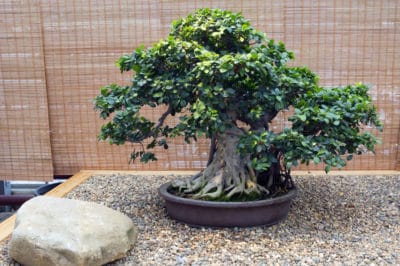About Figs
Figs are members of the mulberry family, which also includes banyans and Osage orange trees. Most originated in the tropics or in areas like the Mediterranean, although many varieties have adapted and can be grown in USDA Zones 6 through 11. All produce a milky latex sap – the rubber plant is a member of the fig group – and many produce edible fruit.
Choosing Fig Varieties for Bonsai
Although many figs can be turned into bonsai specimens with a little effort, certain types and varieties tend to be more popular. Different varieties may be called by the same common name. Bonsai candidates include:
- Ficus retusa – Chinese banyan
- Ficus ginseng – Chinese banyan
- Ficus benjamina – weeping fig
- Ficus microcarpa – Chinese banyan
- Ficus salicara – willow-leafed fig.
Choosing a Container
Most bonsai experts recommend starting with a training pot. The material of the pot doesn’t really matter but the pot should hold enough soil for the projected size for the plant. It should also have very good drainage to prevent the soil from becoming waterlogged. Once the plant is properly shaped, most growers change to a display pot – typically made from clay or porcelain.
Fig Bonsai Care
Water your bonsai whenever the soil gets dry and mist daily to maintain humidity. Fig bonsai in warm rooms may need more water; make sure the pot is draining well. Pruning is required to shape the plant and keep it small. Many growers prefer liquid organic fertilizer, as it can be diluted half-strength with water – apply every one or two weeks. Provide 12 hours of bright indirect light every day.
Wiring Fig Bonsai
Wiring is used to direct the branches and trunk in the direction you want them to grow or to fuse branches together. Thin to medium branches are easiest to wire. You can also use guy-wires to pull larger branches into position. Pad the trunk or branches as necessary to protect the bark. Check wires at least once a week as they can quickly cut into the bark and may damage or even kill branches.
Potential Problems
Giving your fig bonsai proper care is the best way to avoid problems. Over-watering is the most common issue and leads to rot and fungus. Inadequate light can make the plant drop leaves. A ficus weakened by poor care is more likely to be susceptible to insect attacks, with scale and spider mites the most likely. Use an organic insecticide only if necessary.
